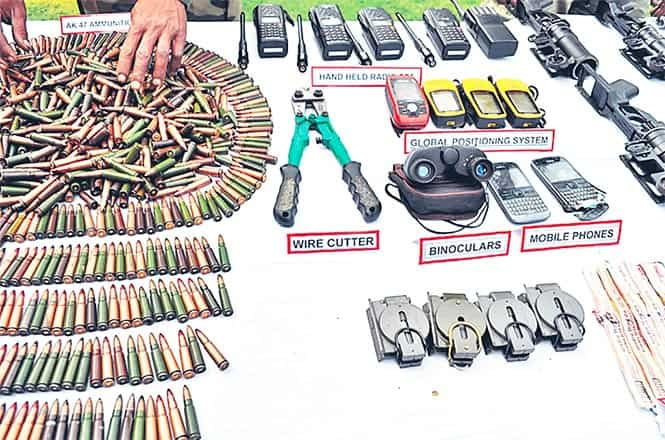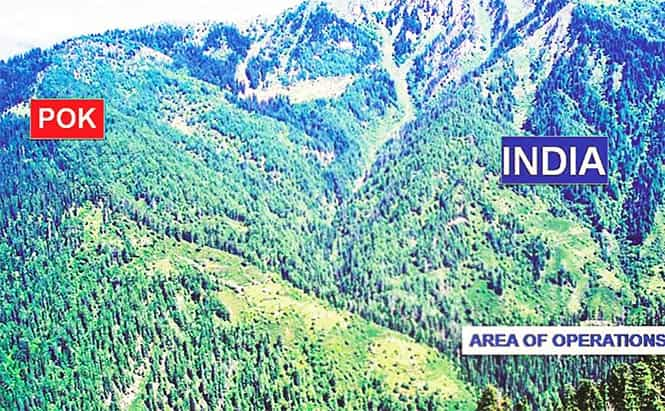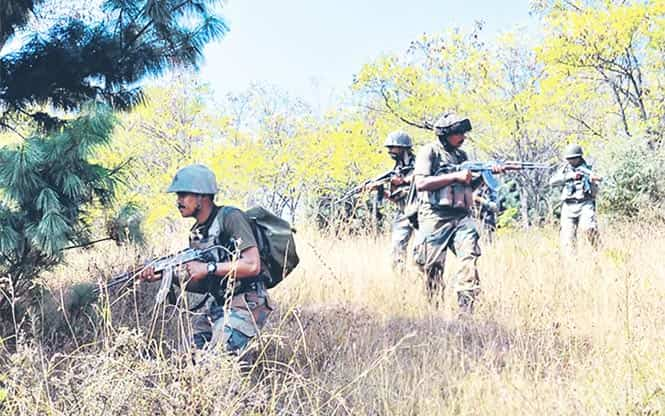Army vs militants: a mysterious encounter in Keran
How did as many as 30 to 40 terrorists manage to come into Indian Territory and engage the army? How did they disappear without a trace? Harinder Baweja reconstructs the encounter.
How did as many as 30 to 40 terrorists manage to come into Indian Territory and engage the army? How did they disappear without a trace? Harinder Baweja reconstructs the encounter.

The night of September 23 was a normal but tense night, like most others, along the volatile Line of Control (LoC) in Jammu and Kashmir. In Kashmir’s Keran sector, particularly in the Shala Bhato area, Indian troops were assessing the enemy. In many areas, Pakistani posts are visible and in others, thermal images are used to make assessments.
In the area across Shala Bhato, Indian troops could see four men sitting around a table playing cards. This apparent sense of normalcy raised Srinagar-based, 15 Corps Commander’s antenna. "I know the Pakistani army DNA," Lt Gen Gurmit Singh told HT, adding, "I had reports of launch pads (where terrorists stay before making their way across the LoC into India') and heightened activity there. We also had information that senior terrorist's leaders from various militant organisations had visited the pads to motivate their cadre."
Recognising the signals, Singh said he told his men to be on alert. "They will try and do something, be prepared," were his exact words. Prophetic words, indeed, but why were they not prepared is the question that begs an answer? "We were prepared for lesser numbers, not 30 to 40," is the reply.
If India was keeping tabs on its adversary, so was Pakistan. They had precise information on the goings-on in Shala Bhato area in Keran. Comprising a frontage of about 3 to 4 kms in length, the area is located at a height of 9000 to 12,000 feet and comprises dense jungle with thick, tall trees. Several ridges divide the four km area and a nullah or rivulet zig zags its way through the area where only a few wooden huts, long abandoned, still stand. There is no civilian population and it is truly the army’s domain.

Here, 3/3 Gurkha Regiment, a new unit had arrived to take over from 30 Kumaon. The process of handing over and taking over usually overlaps for three months before the operational command formally passes to the new unit. The Pakistani army across the LoC, that was also keenly keeping an eye on its adversary, knew the precise day on which the operational command was transferred.
On September 24, troops belonging to 3/3 GR occupied posts in Shala Bhato for the first time. As the sun set over the mountainous region and the troops took position in posts, they heard the sound of heavy firing. All the ridges reverberated with the sound of gunfire.
Rifleman Duluraj was in one such post along with three other colleagues. He took a bullet in his abdomen and is now recuperating in the Army Base Hospital in Srinagar. Speaking to HT from his hospital bed, he recounted the events of that night as he saw them. "I was inside the post when firing started at about 8 o clock. It continued all night and at one point I saw 30 to 40 militants trying to cross the fence on the line of control. It was a moonlit night and I could clearly see the large group. They were trying to cross the fence at multiple points. I was wearing a bullet proof vest but a bullet hit me in my abdomen area, just below the vest and I started bleeding profusely. I was hit at about 4 in the morning and my buddies informed the platoon commander on the Motorola set, who in turn, informed the commanding officer. About two hours later, when first light broke and the firing stopped, eight porters came and took me out on a stretcher."
The stretcher carrying Duluraj took four hours to reach the helipad. The terrain is treacherous and evacuating casualties is a gruelling task that involves a journey through dense forests. Porters have to walk steadily downhill before they reach a makeshift helipad where a helicopter — pressed into emergency service after the CO radioed his seniors about the injury — was waiting.
Rifleman Duluraj was immediately flown to Srinagar’s Base Hospital for a six hour operation in which doctors found six punctures in his intestines. But back in Shala Bhato, the gun battle continued. Some things were clear by now: in a well-strategized operation, terrorists backed by covering fire from the Pakistani army, had made their way into Indian Territory, not from one place but across multiple points. In the beginning, their strength was even assessed at 50 to 60, though in official briefings to the media, the number was kept at 30 to 40.
The terrorists appeared to have the advantage, from all counts, though no officer is willing to say that on record. They hid in the nullah and behind trees and even dug trenches in the forest, from where they fired, often incessantly. On day two, i.e. September 26, the Indian army reported two more non-fatal casualties from the site of the encounter. Rifleman Tejinder KC who was hit by a mortar splinter, spoke to HT from his hospital bed and described the encounter as "intense." He was in a post, initially manned by two but the strength was doubled after reinforcements were sent in, once the attack had begun the previous day. KC says he spotted ‘’three to four terrorists’’, but they were hiding behind trees and disappearing into the nullah, so it was difficult to say if any of them took a shot in the retaliatory fire from the Indian side.

Similarly, rifleman Yo Bahadur Gurung, who was initially with the commanding officer on the 24th when the battle began, was then on duty on the 28th at a medium machine gun (MMG) post. Part of a three hour duty cycle — man the post for three hours and then rest for three, in a bunker close-by — Gurung was walking from the post to the bunker when he was hit by a bullet. The terrorists had Indian posts in clear sight and were taking direct, precise aim. Gurung fell, after the bullet hit him at six o clock in the morning. The terrorists had Indian posts in clear sight and the Indian army had to provide cover fire to ensure movement of its soldiers from posts.
HT interviewed four of the six injured jawans and it is clear from their accounts that the terrorists were at an advantage, at least in the initial three to four days. The terrorists, emboldened after night fall, would take aim (they knew the location of the posts), open heavy firing and then recede into the thick jungle or simply disappear into the nullah. For the first four days that the battle raged, Indian soldiers spotted terrorists in two’s and three’s, but each injured soldier said that they would then quickly retreat behind trees, after which it was not possible to specify their locations because “we could not see beyond 50 metres."
Wing Commander Abhijit Lal, the surgeon at the Base Hospital, who operated on the injured said, “Most of them were critical when they arrived but are now out of danger.’’ The injuries suffered by the jawans and their accounts of the battle make it clear that the army and the terrorists were engaged in a prolonged and heavy gun-battle.

The story surrounding the gun-battle, however, got murky and mystifying after claims from the Army that they had killed 10 to 12 of the infiltrators and that their bodies had been sighted. Corps Commander Singh addressed a press conference in Srinagar to refute claims in the media that the infiltrators had occupied Indian posts, and in the course of the same briefing talked about sighting bodies. When asked what the two most tense moments of the protracted 15 day encounter were, Corps Commander Gurmit Singh said, “One, when HT met him, a day after the army had officially called off the encounter in Shala Bhato and asked him what his two mot tense moments were, he replied, “The first was, where did the bodies go and the second was when they (the terrorists) opened fire on October 2 and we realised that they are still there.”
From Singh’s account, it is clear that there was pressure to locate the bodies — and he admitted as much. In fact, a senior government official in Delhi told HT that they had asked the army to ‘’show the bodies to the media.” Quite clearly, after the last exchange of fire on October 2, the focus of the operation shifted to gathering proof to showcase the Pakistani hand behind the terrorists who had come into Indian Territory.
From Singh’s own account to HT, eight search teams comprising 150 soldiers scoured the jungles and ravines from October 3 to October 8, for bodies and weapons left behind. On October 8, the operation was finally called off and the army was forced to admit that they had not been able to recover any bodies. Said a senior army official on the condition of anonymity, “The media glare increased the pressure as it started counting the days, saying Karen Op enters day 13, day 14.”
As the army now does a post-Op post-mortem, it finds it has many holes to plug and many situations to be prepared for. The most obvious is the possibility of terrorists across the LoC trying to infiltrate into Kashmir before the onset of winter when the heavy snowfall makes it difficult for them to cross the mountain ridges.
That however, is the easy part. The more difficult aspect that will have to be taken into account is the fact that terrorists — with or without the backing of the Pakistani army — have succeeded in hitting the army through spectacular attacks, in which the army has been found wanting.
Four such attacks have already taken place in 2013. First, in January, two Indian soldiers were brutally killed in the Poonch sector, of which one was beheaded. Again, in August, five soldiers were shot at close range while they were sleeping on the LoC, an internal inquiry has found. Then, on September 26, three terrorists managed to cross the international border in the Jammu sub-division and run over a police station in Hiranagar, after which they gained easy access into an Army camp in Samba. Two days prior to that, in a completely different area — this time in Keran in the Kashmir Valley — heavily armed terrorists came into Indian Territory, engaged the army and simply disappeared without a trace.
After the Keran operation was called off, Army Chief, Gen Bikram Singh squarely put the blame on Pakistan. He had enough evidence of the Pakistani hand. Equally true, however, is the fact that there have been lapses that Pakistan-backed terrorists have exploited and these need to be urgently plugged. The battle has only become tougher.
2013: The year of provocation
January 8: Two Indian soldiers were brutally killed in the Poonch sector, of which one was beheaded. PM Manmohan Singh said: “After this barbaric act there cannot be business as usual (with Pakistan).” When it was pointed out to him that Pakistan remained in denial mode on the cross-LoC raid and ambush of Indian soldiers, the PM said: “We will keep on trying”.
August 6: Five soldiers were shot at close range while they were sleeping on the LoC, in Poonch sector of Jammu and Kashmir. There were allegations that the attackers included members of Pakistani army, a charge that was denied by Islamabad. Defence minister AK Antony said that India would take all necessary steps to uphold the sanctity of the Line of Control (LoC) and was capable of protecting its border.He also said that the Armed Forces have the freedom to respond appropriately to a developing situation along the LoC.
September 24: In Keran in the Kashmir Valley - heavily armed terrorists came into Indian Territory, engaged the army and simply disappeared without a trace.
September 26: Three terrorists managed to cross the international border in the Jammu sub-division and run over a police station in Hiranagar, after which they gained easy access into an Army camp in Samba. PM Manmohan Singh condemning the terrorist attack said, “We are firmly resolved to combat and defeat the terrorist menace that continues to receive encouragement and reinforcement from across the border. Such attacks will not deter us and will not succeed in derailing our efforts to find a resolution to all problems through a process of dialogue.” When Singh met his Pakistanicounterpart Nawaz Sharif in New York on September 29, national security adviser Shivshankar Menon told reporters, referring to the Line of Control in Jammu and Kashmir, that both agreed that the precondition for forward movement in the relationship, which they both desire, is really an improvement of the situation on the LoC.

Some Unanswered Questions
1. The Army said they had intelligence on a possible infiltration attempt and were prepared. So how did a large group manage to come in and that too from multiple points ?
2. In the recent past the Army has come under attack during change over of units, when the guard is down. The same happened in Shala Bhato. Why?
3. In a press conference in Srinagar on Sept 26, the Army said they have sighted 10 to 12 bodies of terrorists but none were found. Were the bodies dragged back by the militants or did the Army overstate its claim ?
4. Did the operation extend to 15 days only because the Army was desperately hunting for bodies ? The Army says fire was last exchanged on Oct 2, so what was happening between Oct 2 and 8 when the operation was finally called off ?
Stay updated with all top Cities including, Bengaluru, Delhi, Mumbai and more across India. Stay informed on the latest happenings in World News along with Delhi Election 2025 and Delhi Election Result 2025 Live, New Delhi Election Result Live, Kalkaji Election Result Live at Hindustan Times.
Stay updated with all top Cities including, Bengaluru, Delhi, Mumbai and more across India. Stay informed on the latest happenings in World News along with Delhi Election 2025 and Delhi Election Result 2025 Live, New Delhi Election Result Live, Kalkaji Election Result Live at Hindustan Times.





